Therapeutic apheresis system SPECTRA OPTIA®
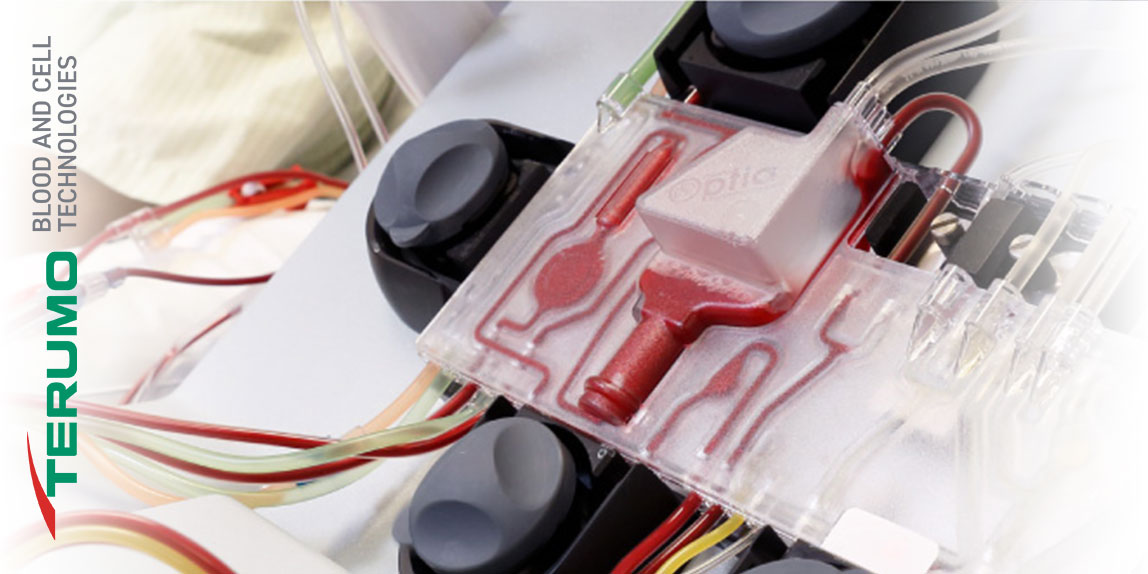
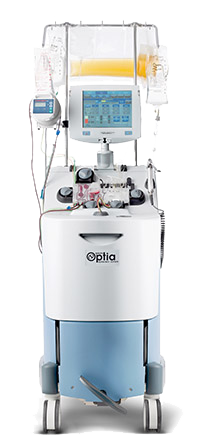
The Spectra Optia System is a system for therapeutic apheresis, cell processing and cell collection platform that allows operators to spend more time focusing on patient care.
This advanced system uses continuous flow centrifugation and optical detection technology, giving operators the ability to perform a wide variety of apheresis procedures on a single platform.
Minimizes training time and reduces inventory and storage with tube sets designed for multiple procedure types
Control procedures with real-time monitoring, interpretation and adjustment with the Automatic Interface Management (AIM) system
Easily move and store your Spectra Optia system with its compact and stable design, including a foldable monitor and IV port
Focus on patient comfort and safety with optimized fluid balances, customized anticoagulation management and low extracorporeal volume tube sets
Access procedure data quickly and easily on the intuitive touch screen, while reducing the need for manual calculations.
One system. Multiple protocols.
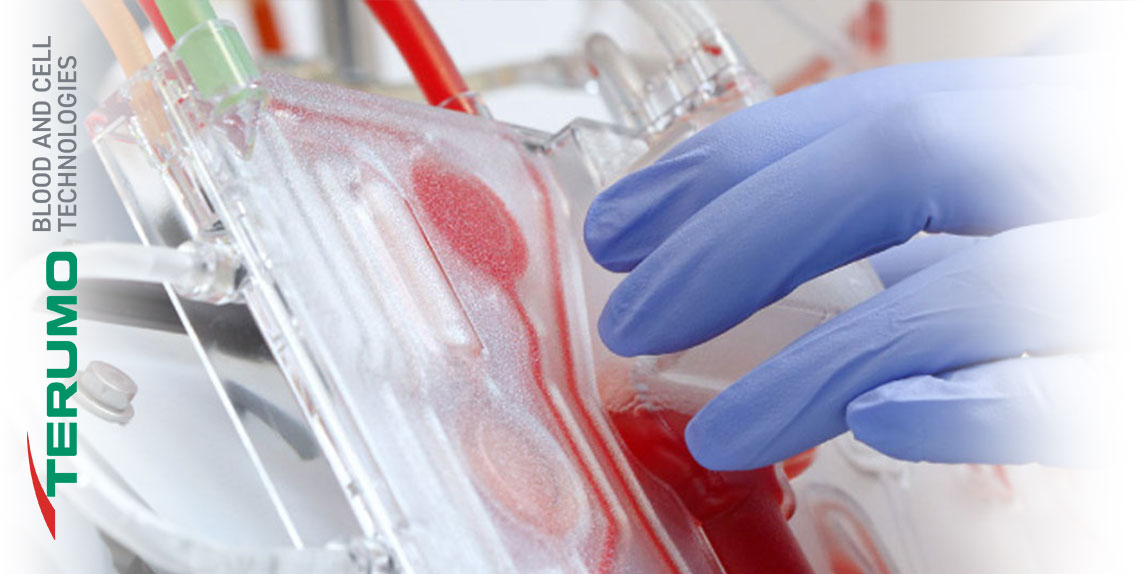

Therapeutic plasmapheresis (TPE)
Because each patient's needs are unique, the Spectra Optia system allows you to tailor the procedure to each patient's specific characteristics.
• 87 percent (± 3 percent) means plasma removal efficiency
• 1.15 total blood volume (TBV) to remove a plasma volume
• 14.4 ml anticoagulant (AC) per L processed whole blood
• Optimized fluid balance is enabled by pump precision
• 1.0 percent median patient platelet loss
• Typical extracorporeal volume (ECV) 141 ml; maximum ECV 185 ml
• Intuitive procedure management
Secondary plasma device TPE (SPD)
This procedure allows you to process patient plasma through columns, filters and secondary processing systems, with features that help advance TPE to the next level of patient care.
• Offers adjustable flow rates to match a range of SPDs
• Mounts and displays pressure readings for SPD with pressure sensor
• Provides an optimised product for secondary processing with an average plasma removal efficiency of 87% ± 3%
• Provides the option to interrupt the system for increased flexibility, allowing more patient attention
• Has dynamic technology that provides consistent and predictable results when performing SPD TPE
• Typical extracorporeal volume (ECV) 141 ml; maximum ECV 185 ml
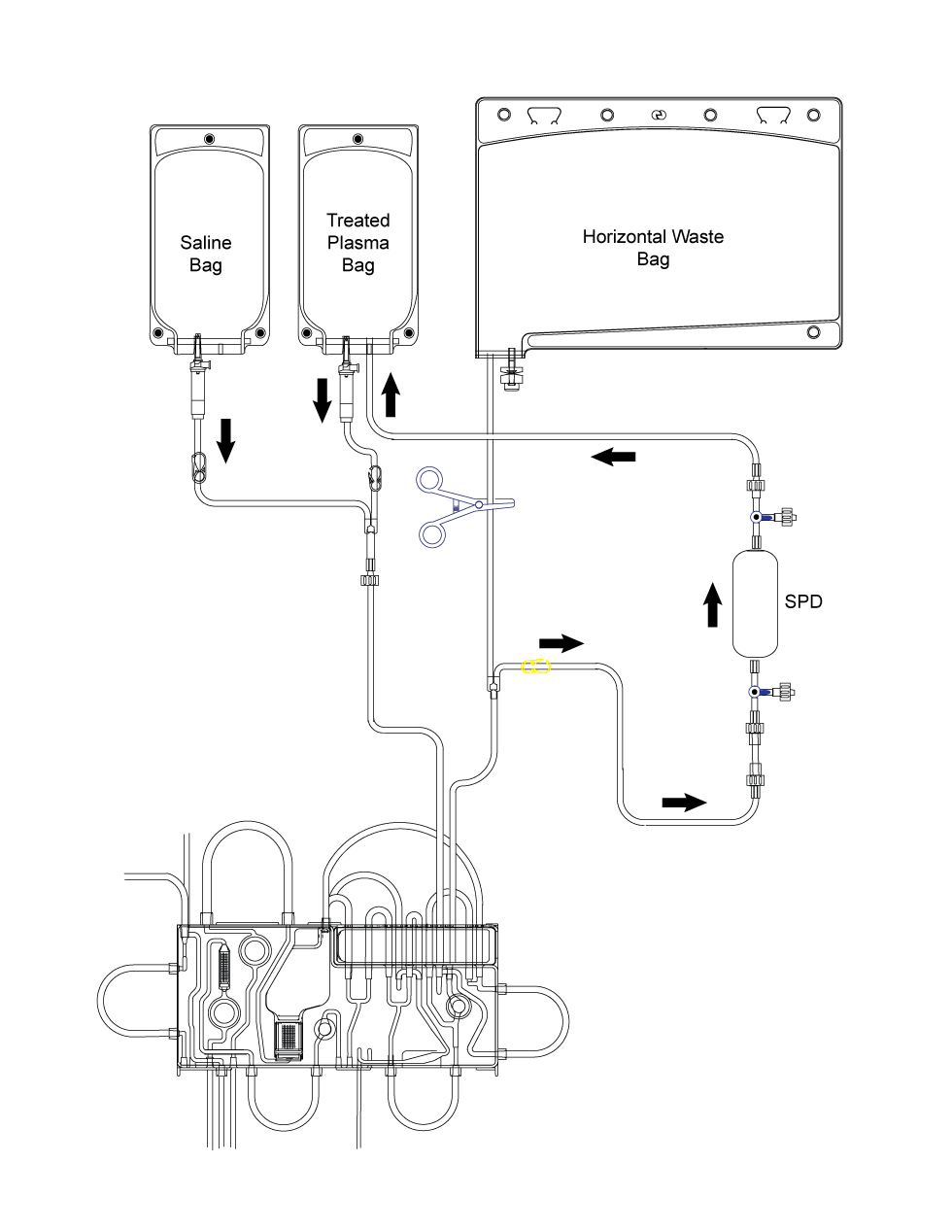
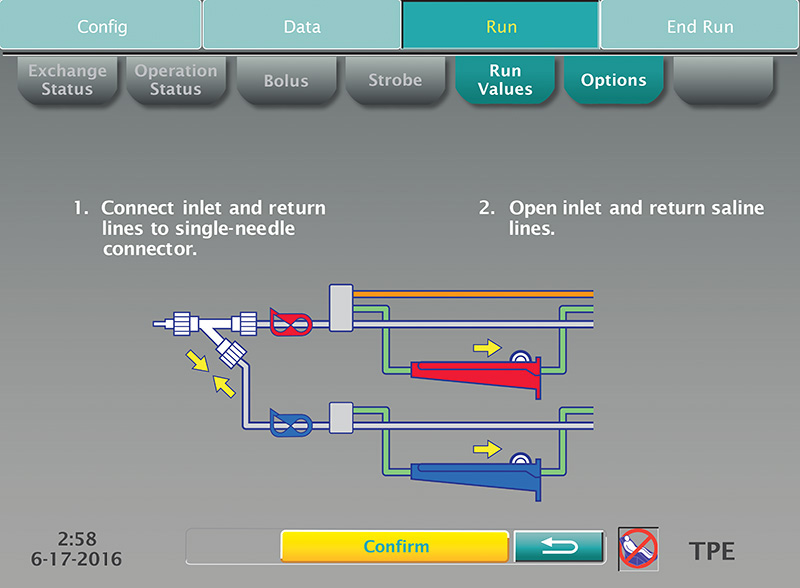
Single needle access TPE
By giving you the ability to switch to single-needle access at any point during a procedure, we help you provide exceptional patient care. Plus, you can achieve a level of performance consistent with dual needle access procedures.
• No additional hardware required; only a Y-connector is needed
• Has the flexibility to use single-needle access from the start of the procedure or at any time during the procedure
• Transition to single needle access with minimal installation time and no loss in system mobility
• Guides you with intuitive touch screens specific to the single needle option
• Typical extracorporeal volume (ECV) 141 ml; maximum ECV 185 ml
Red blood cell collection (RBCX)
Provides the flexibility to perform multiple types of RBCX procedures, each tailored to your patient's needs to help you move forward.
• Carry out exchange, reduction or rebate and exchange procedures
• Covers small patients with a 185 ml tube set
• Improves procedures, allowing operators to spend more time with patients
• Displays a clearly defined custom primary sequence that differentiates blood initiation from the actual procedure
• Provides intuitive procedure management
• Typical extracorporeal volume (ECV) 141 ml; maximum ECV 185 ml
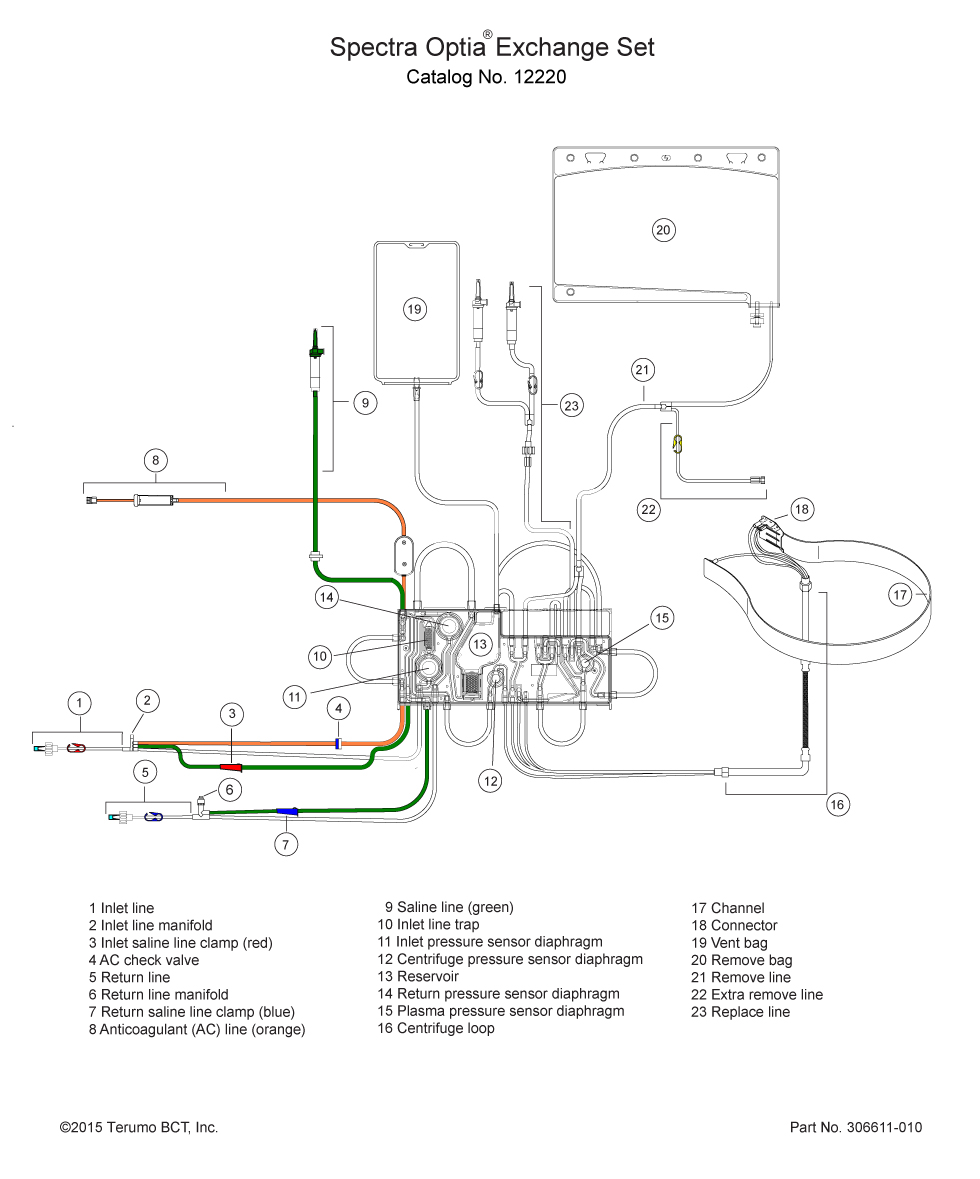
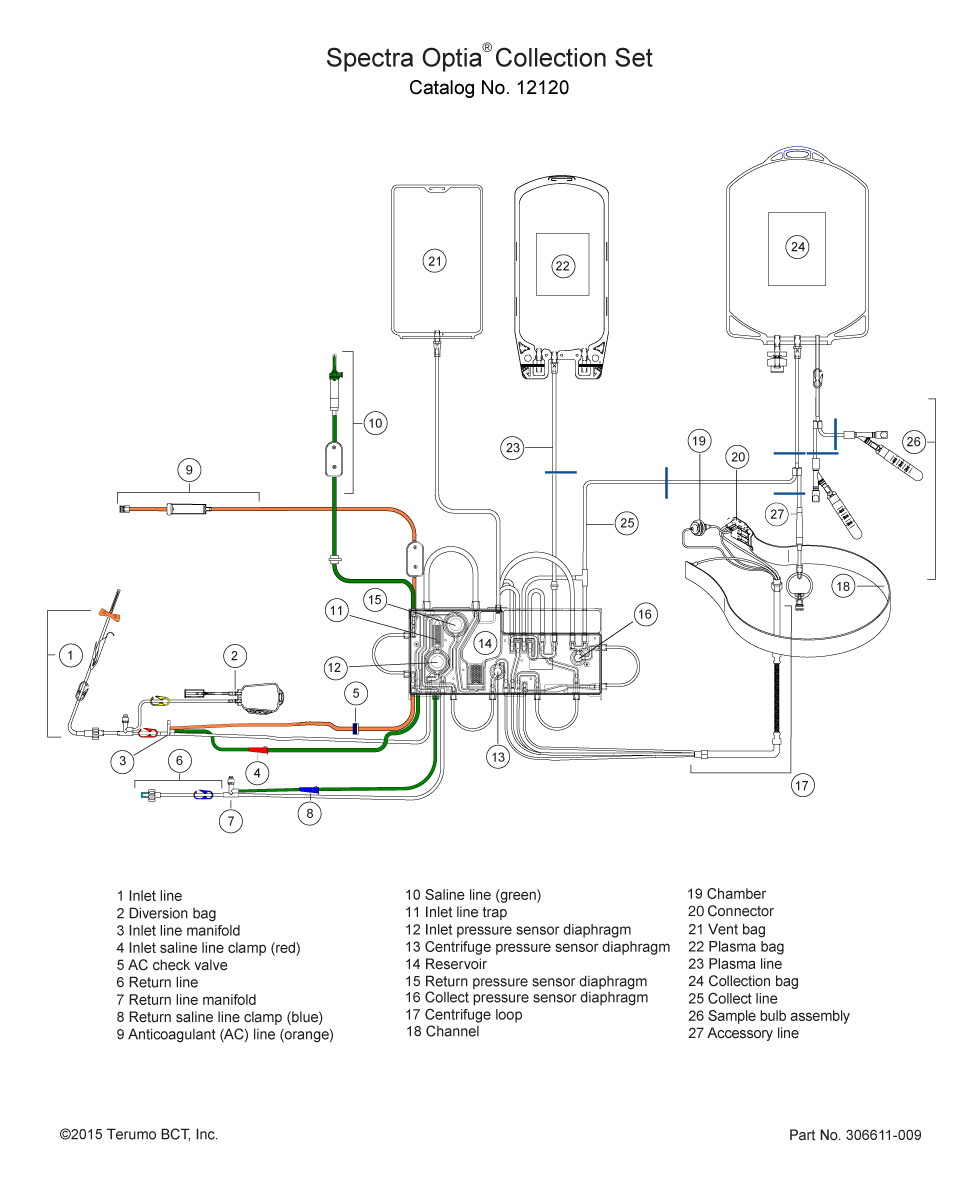
Collection of mononuclear cells (MNC)
The MNC collection protocol brings efficiency, purity and consistency to collections - ultimately benefiting patients, clinics and laboratory processes.
• Efficiently collects MNC, including monocytes, lymphocytes, CD34+ and dendritic cells with low red blood cell, granulocyte and platelet content
• Designed to deliver consistent results with Automatic Interface Management (AIM) for interface stability
• Allows procedural adjustments to optimise collections
• Gives operators the possibility to choose the desired volume of products collected
• Provides operators with the ability to specify and direct competing plasma volume
• Covers smaller patients with a low extracorporeal volume (ECV) of 191 ml
• Protects the product against contamination with a functional closed tube set and a built-in sample bulb
• Typical extracorporeal volume (ECV) 147 ml; maximum ECV 191 ml
Continuous collection of mononuclear cells (CMNC)
Using the Spectra Optia Automated Interface Management (AIM) system and the COBE® Spectra Apheresis mononuclear cell (MNC) continuous flow collection method, the CMNC protocol provides operators with an automated, yet familiar and flexible method for collecting MNCs, including monocytes, lymphocytes, CD34+ cells and dendritic cells.
• Produces consistent results with the AIM system for interface stability
• Improves collection by continuous processing in one step
• Minimizes the amount of operator interaction required, allowing more focused time on patients
• Typical extracorporeal volume (ECV) 253 mL; maximum ECV 297 mL
• The value of the inflow (5 ml/min up to 142 ml/min)
• Collect pump flow (0.5 ml/min to 10 ml/min)
• Packaging factor (from 1 to 20)
• Collection preference (10 to 90)

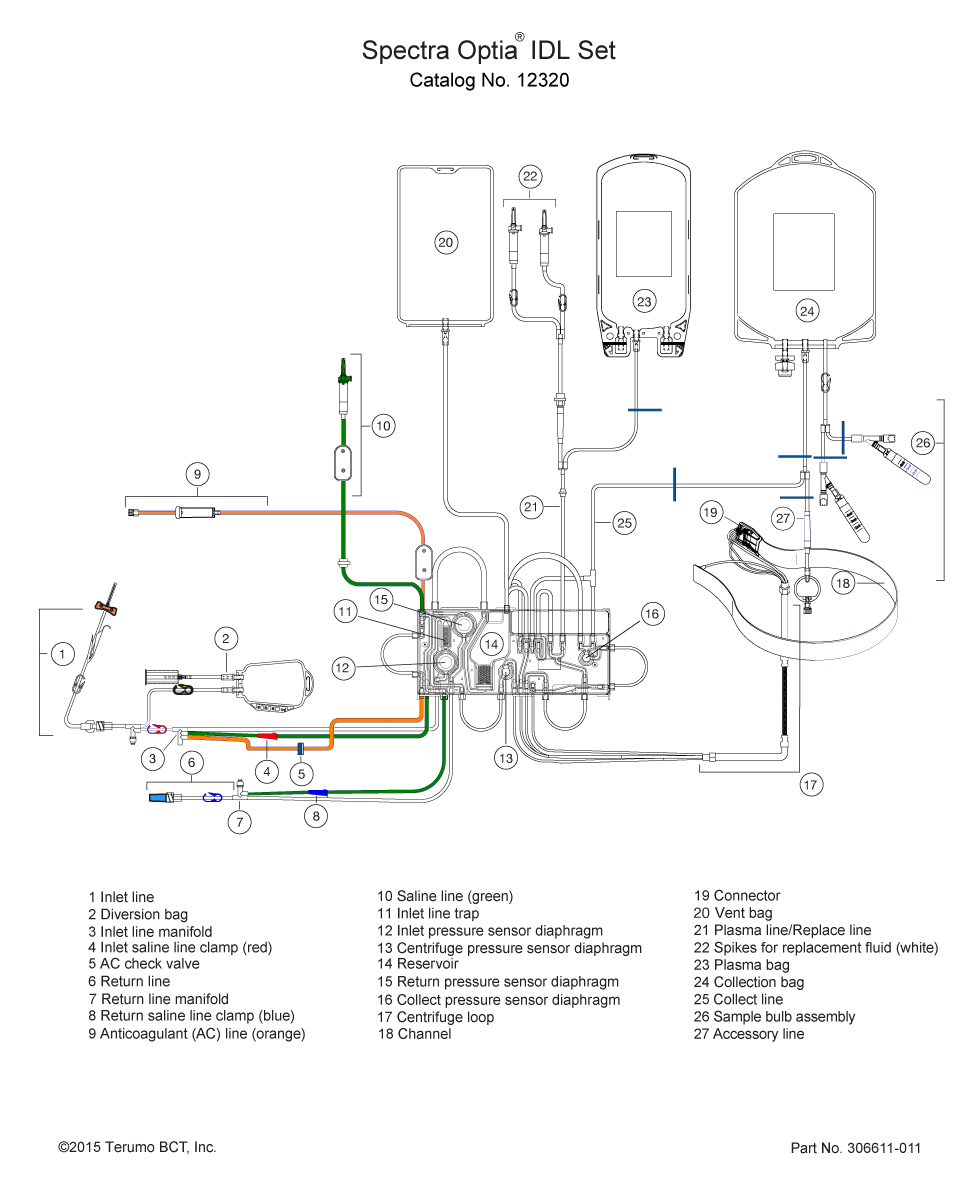
Collection of granulocyte cells (PMN)
Designed to give you both choice and flexibility, the Spectra Optia system helps you optimise every PMN collection procedure.
• Achieves collection efficiency (CE1%) of 51% (39-57%)
• Maintains collection efficiency over a range of inlet pump flow rates by automatically adjusting pump collector flow rate
• Allows low platelet loss; platelet collection efficiency (EC1%): 7 (2 to 11)
• Provides automatic control of collection depth in the red blood cell layer through the reliable performance of the automated interface management (AIM) system
• Uses an intuitive hydroxyethyl starch (HES) option to automatically set an appropriate packing factor based on starch usage
• Typical extracorporeal volume (ECV) 253 ml; maximum ECV 297 ml
Leukocyte and platelet depletion (WBCD)
Whether you need to perform a leukocyte or platelet depletion procedure, the Spectra Optia Advanced System is designed to give you choice and accuracy.
• Maintains depletion efficiency at a range of inlet pump flow rates by automatically adjusting pump intake flow rate
• Allows you to target a specific fluid balance without manual calculations using integrated fluid balance management
• Automatically sets the appropriate packaging factor with an intuitive hydroxyethyl starch (HES) option
• Typical extracorporeal volume (ECV) 253 ml; maximum ECV 297 ml
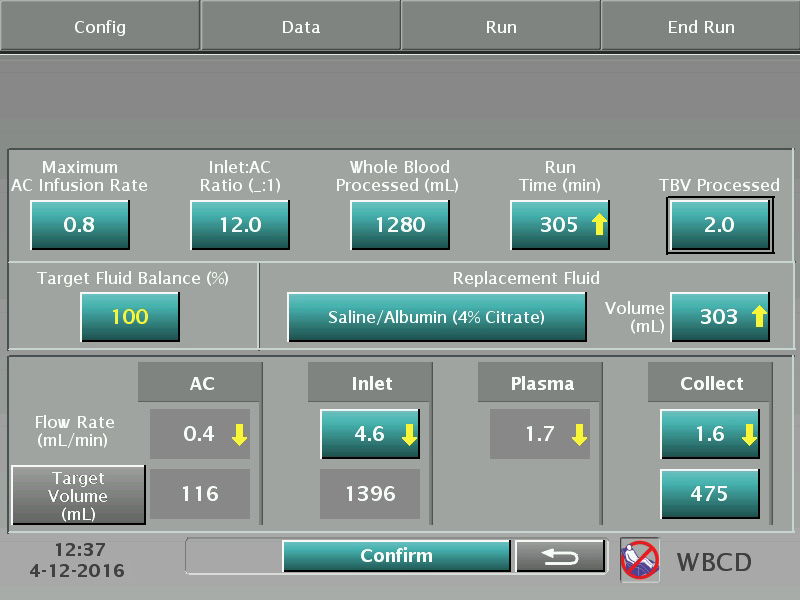
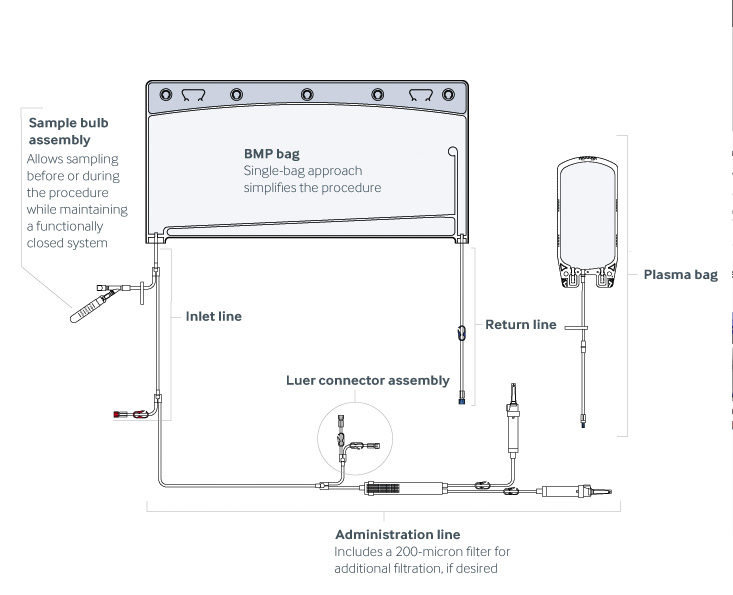
Bone marrow processing for haematopoietic stem cell transplantation (BMP)
With helpful on-screen guidance and a one-bag approach, the Spectra Optia system simplifies BMP procedures.
• Achieves greater than 97% erythrocyte reduction
• Provides a volume reduction of more than 90%
• Produces a final volume of products under 200 ml
• Requires less operator supervision as the system continuously monitors and adjusts the interface
• Typical extracorporeal volume (ECV) 141 ml; maximum ECV 185 ml
Pathogen reduction system MIRASOL®
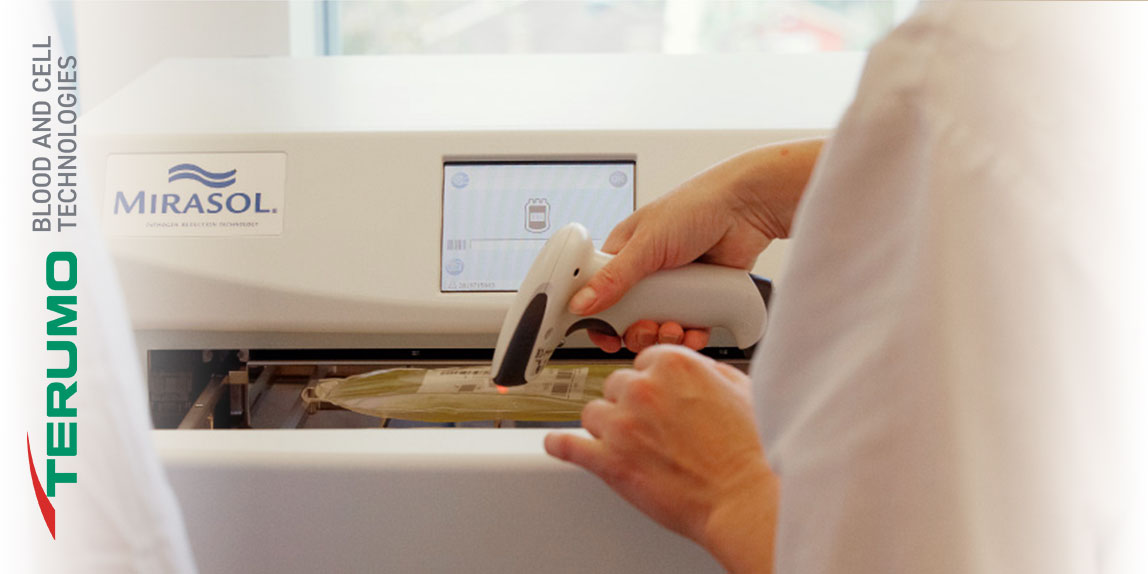
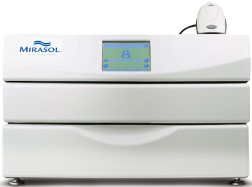
A proactive approach to improving blood safety
No matter where you are, increased travel, climate change, evolving pathogens, emerging pandemics and the need to advance healthcare practices have put global blood safety at the forefront of the industry.
With all these changes, it's time to take a proactive approach to protect patients from the potential dangers of donated blood.
The Mirasol PRT system can help you do this by reducing the pathogen load of a wide range of disease-causing viruses, bacteria and parasites.
The system also inactivates residual white blood cells found in blood components, which can help reduce transfusion reactions in patients.
The right balance for better blood
We believe that improved blood safety should provide an appropriate balance between efficacy and ease of use, while maintaining the quality of blood components for patients who need them. The Mirasol PRT system is a simple system that has the power to provide better patient care while reducing the risks associated with the gift of blood salvage.
The Mirasol PRT system treatment can be used as an alternative to some safety procedures without introducing new risks for operators or patients. Treatment with the Mirasol PRT system can help reduce product waste for blood centres and reduce the total cost of transfusion for hospitals.
The right way to advance blood safety: safe, simple, effective. The Mirasol PRT system uses a combination of riboflavin (vitamin B2), a non-toxic, non-mutagenic compound and a specific ultraviolet (UV) light spectrum to inactivate viruses, bacteria, parasites and white blood cells that may be present in collected blood products.
The Mirasol PRT system consists of three main components:
• A disposable set - includes an illumination/storage bag and sterile riboflavin solution
• Mirasol Illuminator - provides UV light and agitation for Mirasol treatment
• Mirasol Manager software-integrates and manages data reporting and storage
During treatment, a blood product is mixed with the riboflavin solution and placed in the illuminator, where it is exposed to UV light. There is no need to remove riboflavin or its photoproductive products; after illumination, the treated products are prepared for transfusion or storage.
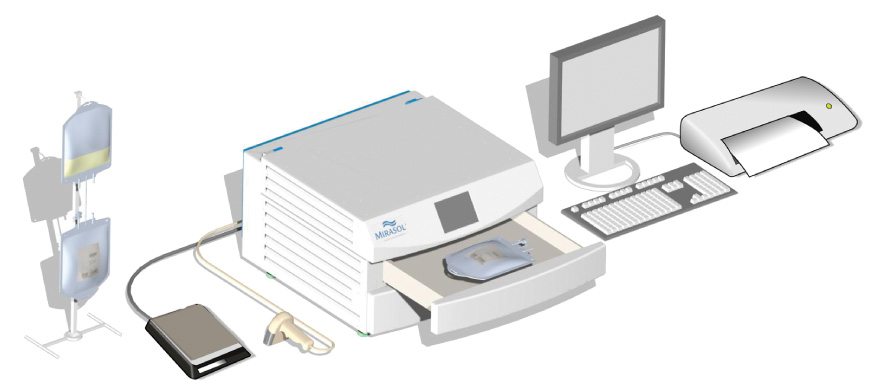
The Mirasol PRT system causes irreversible changes to the RNA and DNA of viruses, bacteria, parasites and white blood cells, preventing them from reproducing and causing disease. Riboflavin + UV light = irreversible inactivation of pathogens and white blood cells
The process in three simple steps: platelets, plasma and now whole blood

Extracorporeal photosphere with Lumilight®
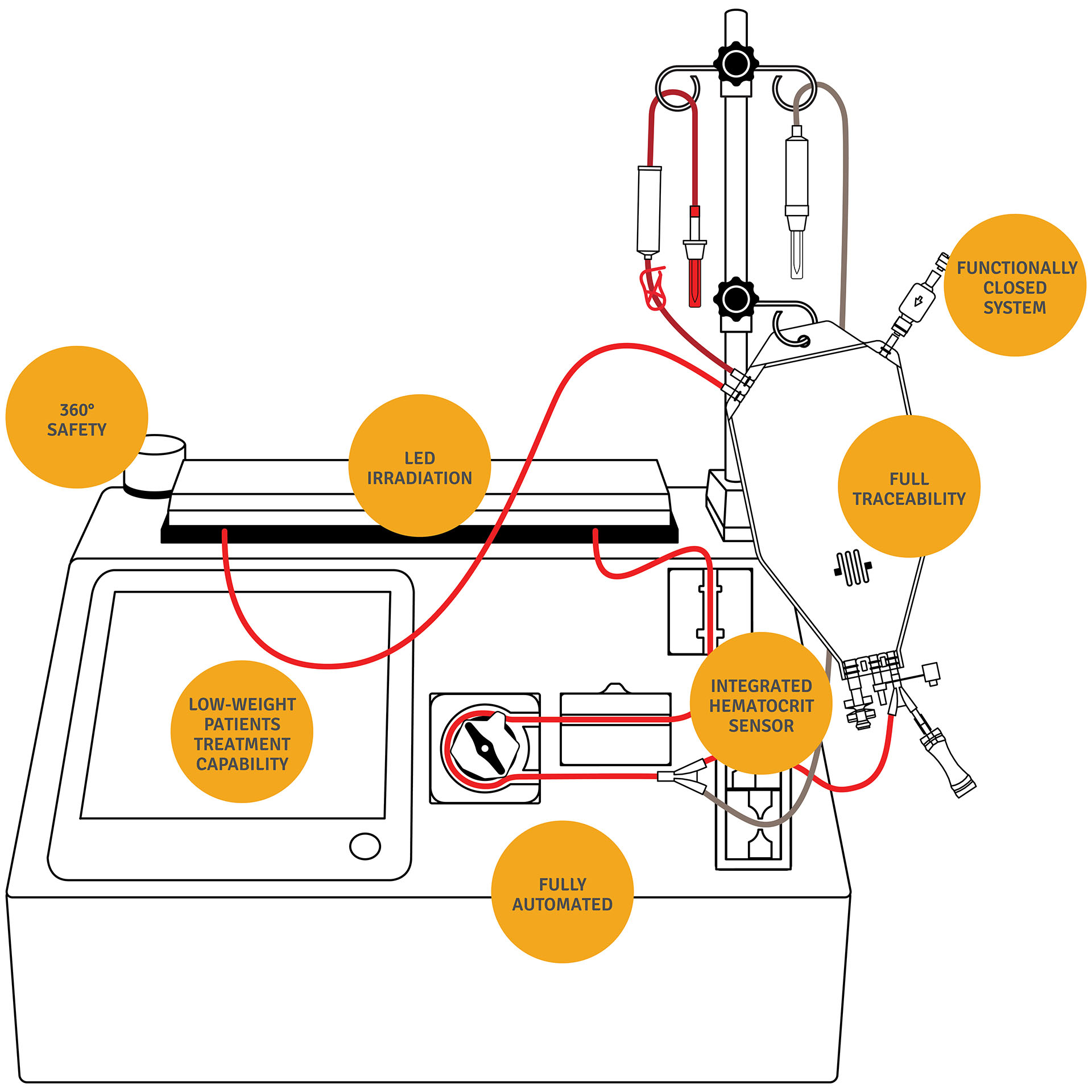
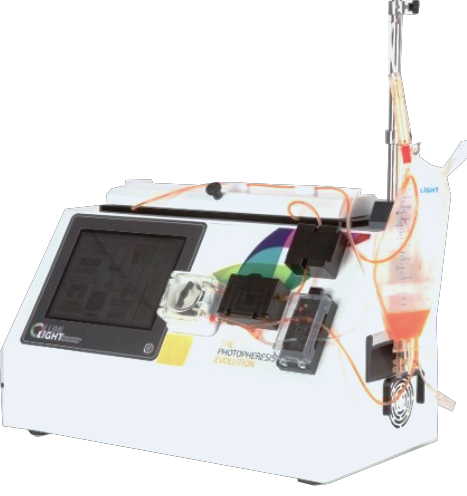
Lumilight is a device that aims not only to improve the efficacy of photopheresis, providing a better response to therapy and consequently improving patients' lives, but also to provide the medical community with a new device and a simplified approach to well-established therapy.
It adopts advanced technology to perform safe treatments according to laws and doctors' prescriptions.
Its extensive automation allows strict standardisation of procedures and grants ease of use and minimal number of blood cells handled.
Lumilight is a Class IIb medical device for the irradiation stage of the extracorporeal photopheresis (ECP) procedure intended for use by trained medical personnel only.


